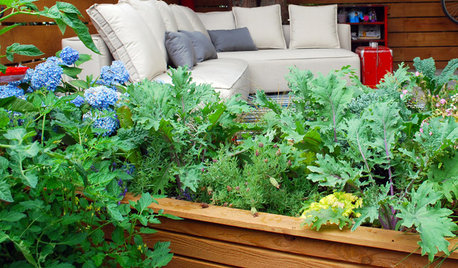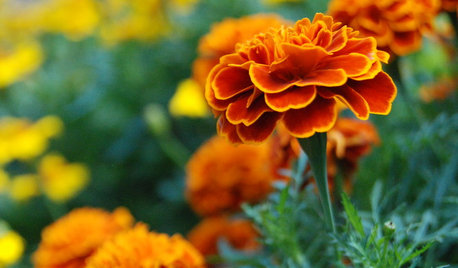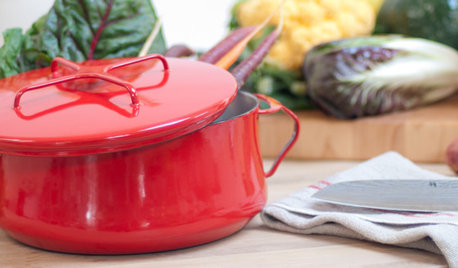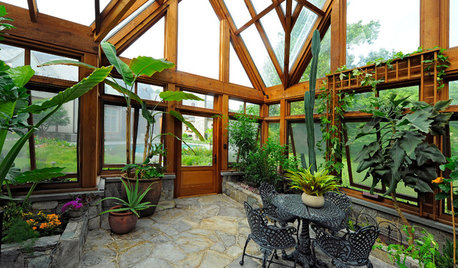Apples in compost
My uncle has about 85 apples trees that are loaded with apples. He does not spray or prune the trees, just picks the apples for friends and family and gives them away. There are literally thousands of apples on the ground now from some storms we got here in southern Illinois. Thankfully along with over 4 inches of rain this past week. What would be the best way to go about using these for composting?
Comments (51)
toxcrusadr
11 years agoYou'll definitely need some dry browns to go with those, since they are relatively high in both nitrogen and water. Layer or mix them with leaves, shredded wood or paper, sawdust, straw, etc. Should make some great compost.
If the piles are big enough to get hot, it should help kill off some of the worms that would otherwise procreate to infest next year's crop.
lovestogrow
Original Author11 years agoI am lucky to have access to truckloads of shredded leaves also. So the browns will not be a problem. Along with the apples I was wondering if that would be enough to make good compost.
Related Professionals
Windham Landscape Architects & Landscape Designers · Essex Landscape Architects & Landscape Designers · Goodyear Landscape Contractors · Stoughton Landscape Contractors · Maple Valley Landscape Contractors · Galveston Landscape Contractors · Lees Summit Landscape Contractors · Lemont Landscape Contractors · Middleton Landscape Contractors · Vallejo Landscape Contractors · Fullerton Decks, Patios & Outdoor Enclosures · Larkspur Decks, Patios & Outdoor Enclosures · Lincolnton Decks, Patios & Outdoor Enclosures · Mitchellville Decks, Patios & Outdoor Enclosures · New Berlin Decks, Patios & Outdoor EnclosuresRpR_
11 years agoYou could do as I do/have done, put them in the ground.
I have found that apples can take a long time to break down.
I bury them eight inch to a foot deep and have found, if buried to green, even after being under-ground through a hard freezing winter, some can still be hard and crispy in the spring.
This year I have buried at least three bushels in the garden but left the holes open for weeks for the heat to soften the apples first, plus I buried cut apples and other kitchen scraps with them to hasten their breaking down.
If you have thousands of apples to use, you will find that you do not have a compost bin big enough to compost them.
One of my two bins is four by four by four and had I put them in there it would be at least one-half full from the ground up.These apples came from just ONE tree.
I have been burying apples for years and they make wonderful garden soil, especially for roses, just put in the ground.
Sadly our seventy plus year old apple tree snapped off in a storm this summer, probably from old age as the wood showed no disease, so no more apples till the sucker tree that I left grow eight years ago is big enough for apples.
lovestogrow
Original Author11 years agoI am thinking about mashing the apples first, would this help them?
robertz6
11 years agoI would mash, squash, or cut them into slices before mixing with leaves or other material. Otherwise they would likely take a long time to break down, and would form wet clumps.
Burying in a hole or trench would be an easy way to save time and effort.
For a few years I had a access to a grocery dumpster, and piled 500 pounds of veggies in my hatchback. But it was too much work cut it all up when I liked hot composting.
toxcrusadr
11 years agoMashing would make them break down the fastest, but would be an awful lot of work for compost. You could just whack them with the back of a shovel to break open the skins, or chop with a machete. This usually speeds things up quite a bit and is very quick and easy.
lovestogrow
Original Author11 years agoActually I was thinking of using a shovel and just giving them a whack. After posting I thought that mashing was the wrong word to use. I just hope I can get the apples balanced with the leaves so they will compost ok.
feijoas
11 years agolovestogrow, I'm very much into using what's around and I say you can absolutely make compost with apples and leaves, although the more ingredients the better the compost, in my opinion.
I'd highly recommend making a batch of cider vinegar. My method's really crude, but effective: that shovel you mentioned...flatten enough apples to 3/4 fill a food-safe 44 gallon drum in the shade of an apple tree, top up with water, loosely cover if you feel like it, ignore for a long time.lovestogrow
Original Author11 years agoMaking cider vinegar sounds pretty cool but tell me what I would do with that many gallons of it?
feijoas
11 years agoI use vinegar for cleaning pretty much everything. Best glass-cleaner around.
It's very good for the inside and outside of animals, including birds, dogs, people...
A hot drink made with cider vinegar, honey and ginger is not only tasty, it's really soothing if you're sick and will arguably speed up recovery.lovestogrow
Original Author11 years agoFeijoas,
I would like to hear more about the recipe for the drink you were talking about. Also a bit more on how long you let the apples and water sit etc. This has me thinking I really want to try this. I am also going to use them for the compost also, I can't see just letting them drop to the ground when they would be good for the compost pile.Any other comments are still welcome on the use for the apples. If anyone ha recipe for hard apple cider or just plain cider, I would appreciate that too.
feijoas
11 years agoI'm happy to take the thread off topic if you are LTG!
Cider vinegar is traditionally made by fermenting apple juice in a vessel that allows oxygen (and vinegar flies) in; pretty much the opposite of making hard cider.
Juicing a quantity of apples is quite a drama, and something I save for making cider.
I've had good results using unwashed windfall apples, roughly cut up with a cleaver and tossed in a foodsafe barrel. Your shovel idea sounds waaay better, although I think a spade would be an even better apple-basher.
Just cover the apples with water, drape an old net curtain over the mix and leave.
It's not a fast process... I'd say a couple of months, minimum. The vinegar will develop a 'mother', a rather freaky-looking translucent-ish floating plug. It's part of the process and I just dig a jug under it.
You can keep the same barrel going for years, just sift out the old apples at harvest time and throw in a new, squashed batch and top up with water.
The drink quantities are very dependent on individual taste and the vinegar's strength, but it's basically grated fresh ginger, honey and vinegar to taste. Lemons are a good alternative to vinegar.
Cider vinegar is apparently excellent for people with circulatory problems.
I use it a lot for cooking, especially vinaigrette.
And I'd definitely try to put apples you're not using for food in the compost: apples left on the ground can increase disease and pest problems.jonfrum
11 years agoEarlier this year I read a post on another forum - sorry, I don't have the link - by a guy who composts horse and cow carcasses in big farmyard-sized compost piles. He said that in about 6-8 months, there's nothing left but hooves and bones. You can compost ANYTHING organic under the right conditions, and if you're willing to wait. I'd suspect that mashed apples would attract critters, but other than that, I'd go for it. As long as you have the space and time, there's nothing to lose.
Laurel Zito
11 years agoApples do not take a long time, if you are hot composting, but it can help to poke them to allow the bacteria to go in. You can crush them, a lot of work, or just poke them with a knife. If they are not rotten to begin with and not poked, they will take a while.
albert_135 39.17°N 119.76°W 4695ft.
11 years agoCornell has some connections with something called Farm Services which composts, among other things, orchard waste. It appears one may have to contact them to get more details.
toxcrusadr
11 years agoDoes the vinegar have to be pasteurized before use? I tried to make some once with some cider that sat in the fridge too long. Left it out on the counter with cheesecloth over it for a week or two. I tasted it, and it tasted like vinegar, and I barfed an hour later. Pretty sure something other than acetobacter was living in there.
Laurel Zito
11 years agoI put moldy stuff in all the time, it's good for the compost, the more spoiled the better.
rickd59
11 years agoI agree with RpR, I'd bury them. I'm sure you don't have a rodent-proof aerobic compost system that will handle fruit from 85 trees.
I'd bury them in a series of parallel trenches that are about 3' wide and 3' deep. Dig one trench, set the soil to one side, fill with apples (preferably alternating apples/leaves, but even fruit alone would be OK, IMO), then dig another trench adjacent to the 1st trench and about a foot away, piling the soil on top of the 1st trench, and repeat this until you run out of apples. The soil backfilled over the apples will prevent rodent or insect problems. Try not to walk, use heavy equipment, or otherwise compact the area while they're composting. I would cover the top with mulch, if possible (leaves or arborist wood chips would be perfect), to maintain soil moisture. In 6-12 months, after the mounds of soil have settled, I'd plant a deep-rooting green manure crop over the top.
I wouldn't go to the trouble of crushing them but piercing the skin would definitely speed things up. Should make great soil after the worms have done their magic.
Some gardeners would argue that burying green waste causes anaerobic decomposition and generates methane, a greenhouse gas. I would agree but I don't know of any alternative or how to quantify the problem, e.g., how much methane. I think that commercial vermicomposting operations also produce methane.
lovestogrow
Original Author11 years agoWell I am not going to use all the apples from 85 trees, just the apples that are left or what I am willing to pick up. It sounds like it might be a good idea to dig the trenches but I am wondering why dig them 3 ft deep? Wouldn't it be better to dig about 18 inches them fill them to about 6 inches from the top then cover with dirt?
theresamh
11 years agoWe've only got 2 trees remaining from a mixed orchard that was mature in the early 1950's. 1 is a Duchess apple tree. A number of years when my mom was the sole resident here and she was older, the fruit would all or mostly rot where it fell. The yellow jackets had a field day and a fallen apple was gone in less than 2 weeks. Now 85 trees might tax those little bee tummies but I'd think just leaving them exposed for a couple weeks (the fallen apples - not the bee tummies :-)) would really get the rotting process kicked into high gear.
rickd59
11 years ago@lovestogrow, you could go down only 18 inches. I suppose it depends on how much area you have available for this, the number of apples, and your tolerance for digging. I said 3' because that gets organic matter down in the zone of most of the food crops that I would normally grow (I've dug out roots of grapes and small fruit trees at that depth). But I wouldn't argue with a 2' trench either. I would fill them all the way to the top since you'll be putting plenty of soil over them.
@theresamh, I agree that leaving them on the ground starts the rotting process, but it also attracts insects and rodents. In my area that means houseflies and rats, both of which I try to avoid.
RpR_
11 years agoI have left the apples on the ground and even mowed over them to help slice them but at time when I raked them and put them in a wheel barrow, I was surrounded by wasps.
Now they left me alone but those who have fear of having dozens swarming around them might have a problem.
bug_girl
11 years agoJust piecing and adding to the bin is as good as being on the ground or better. I added some last month, and I they are almost all finished, only the less rotten ones remain and if I squeeze them they fall apart in my gloved hand.
lazy_gardens
11 years agoWould a local food bank be able to send volunteers out to scavenge them? Phoenix hyas something called "Local Harvest" - a group that will come pick your overloaded citrus trees for local food banks.
If you know anyone with cows or sheep, turn them loose in the orchard to eat the windfall apples.
And while you are gathering them, watch out for bears. They will gorge themselves on apples in the fall. (if shot after they have fattened on apples, they are very tasty.
ma_guy
11 years agoIf you've got the truck, why not wrap the apples in a tarp (loosely) and drive over them a few times first? This will dramatically increase the compost speed.
robertz6
11 years agoI second the idea of mashing them or just driving over them first. If small kids are available, have them jump up and down on a tarp full of apples. Last year I put out a trash can marked 'Recycle Pumpkins can'. Then got out a large tarp and told the neighborhood kids to throw them up in the air and have them land on the tarp. Saved me some work cutting them up.
Aiden Thomsen
7 years agoI think you should do this
1Choose a spot in the yard or garden for a compost pile, if you have not started one already. The compost pile should be away from the house because it may attract bugs or small animals. Some people purchase a composting bin because they think it looks neater, but this is optional.
2
Toss apple cores and apple peelings onto the compost pile every day. Old apples that are no longer good to eat may also be thrown onto the compost pile. The apples are considered green debris. Toss dead leaves fallen from trees and some soil onto the apples. These are considered brown debris. The best ratio in compost is one part green to two parts brown debris.
3
Add a little manure from a vegetarian pet, such as a rabbit or a hamster, to the compost, if desired. You may also purchase compost starters from home and garden supply stores. Manure and starters are optional; your compost will break down without them if you tend to it every day.
4
Sprinkle the compost pile with water if it does not rain every few days. A dry compost pile will not break down.
5
Turn the compost with a shovel or pitchfork to mix it well. Do this every day while the pile is still small. Once you have three cubic feet of composting material, you may turn the pile as infrequently as once per week.
Here is the linkalbert_135 39.17°N 119.76°W 4695ft.
7 years ago''The best ratio in compost is one part green to two parts brown debris.'' If I don't have enough green can I use food coloring?
daninthedirt (USDA 9a, HZ9, CentTX, Sunset z30, Cfa)
7 years agoYeah, green and brown as indicators of protein and carbohydrate are pretty simplistic. What counts isn't green and brown, but proteins (which contain nitrogen) and carbohydrate (which are all carbon). Plenty of browns are nitrogen rich, and what makes leaves green really isn't the dominant source of nitrogen by a long shot.
But instead of food coloring, I'd shoot for green turf dye.
daninthedirt (USDA 9a, HZ9, CentTX, Sunset z30, Cfa)
7 years agoYes, fresh pee is a remarkable source of nitrogen, though it isn't green. Green pee? Urobilin, which is what makes pee yellow, actually has a lot of nitrogen, but it isn't the main nitrogen containing constituent of pee, much as chlorophyll, which makes leaves green, isn't the main nitrogen containing constituent of leaves.
toxcrusadr
7 years agoIf your pee is green, you have serious problems! LOL
On the brown and green topic...It is generally taught, and assumed, that 'green' means high in nitrogen, not green in color. Although many high-N things ARE green such as grass clippings, garden and kitchen scraps, and green leaves. Obviously fresh manure is a composting green but brown in color. I suppose it may be more accurate to say high nitrogen or high protein, but when you're teaching newbies (as I have done, for many years) they are going to have to learn it one way or another, and I am not convinced that a rookie can learn it better by any of those methods of sorting. That's why we hand them a list. I always talk about nitrogen and carbon too. Eventually everyone learns what's high in N and what's not. If you asked a newbie whether fresh manure was high in carbs or protein they would not know the answer, any more than they would know whether it's high or low in nitrogen. Nitrogen is not all in the form of proteins in all compost materials anyway, especially if already partially decomposed.
It's funny that I would argue this point, as a chemist, because I do like accuracy, but teaching laypersons is a whole different deal.
toxcrusadr
7 years agoOh, one more thing about the orchard that started this thread in 2012. Assuming that the apples 'go to waste' on the ground and would be more beneficial in the compost, is not necessarily correct. Decomposing in place puts nutrients back into the soil just as effectively. Some are saying that in-place composting (i.e. burial) actually captures more nitrogen because it off-gasses from an active compost pile. Composting is neat and organized, it has many advantages, we all do it so it's not a wrong thing, and it sure beats the landfill, but it may not be the ideal solution in every case.
daninthedirt (USDA 9a, HZ9, CentTX, Sunset z30, Cfa)
7 years agoWell, teaching a layperson that nitrogen rich stuff is green is simply wrong, and at the least, overly simplistic. I think that laypersons ought to at least be taught that it's a simplification. I'm afraid it isn't true that It is generally taught, and assumed, that 'green' means high in nitrogen, not green in color. Taught in ag classes, certainly, but not on gardening websites. I see repeated references to getting "greens" and "browns" right for compost, without ever spelling out what you're trying to achieve by doing so.
Very good point that apples laying on the ground are basically in situ composting. I do suspect that composting in a pile rather than in a lump will end up retaining more nitrogen, though, because the latter will be less effective in retaining outgassed ammonia and nitrifying it.
avgusta_gw
7 years agoSince all browns were green before, may be it would better call it fresh stuff to dry out stuff.
daninthedirt (USDA 9a, HZ9, CentTX, Sunset z30, Cfa)
7 years agolast modified: 7 years agoDoesn't work that way. Hay is a "green" and straw is a "brown". They're both dried out grass. But hay is harvested when it is green so it contains loads of nitrogen containing proteins. Straw is harvested when it is dead. It's all carbs. If you pulled green leaves off a tree and let them dry out, they would, in terms of protein chemistry, be a "green".
Leaf sensescence is the process by which leaves die naturally. When they do, the nitrogen containing proteins are reabsorbed by the branches or roots.Which is why stripping green leaves off a tree really isn't very good for the tree!
Again, thinking that colors are biochemically meaningful is a mistake.
By the way, all browns were not greens before. This has been a mast year for acorns, and I've got BROWN acorns all over the place. They are fantastically rich in proteins, and would be classified as a "green". They're heating up my compost pile nicely, once crushed.John Donovan
7 years agolast modified: 7 years agoLast winter my neighbor gave me 2 yard waste recycling bags full of apples to compost. I am not sure how many actually composted down by spring but there wasn't many left when I checked my compost come end of march. I am sure more then a few fed local wildlife.
daninthedirt (USDA 9a, HZ9, CentTX, Sunset z30, Cfa)
7 years agoI shred my leaves with a lawnmower. Seems to do a pretty good job on the acorns. I guess you could run them over with a car too.
ma_guy
7 years agolast modified: 7 years agoI can tell you from experience that driving a passenger vehicle over my (inedible, very hard) apples doesn't work. They distribute the weight so effectively that they don't crush. I imagine that most varieties probably crush easier.
Next year I intend to build a scratter to break them apart before composting them. The tree typically produces about 13 trash barrels-full biannually.
I wouldn't have thought a typical powered mower would draw up and do a good job of chopping acorns. That's good to know, thanks!
dchall_san_antonio
7 years agodaninthedirt does a better job of explaining greens and browns, nitrogen and carbon, than anyone I've seen. If the material currently has protein in it (apples have none), then it is a green or source of nitrogen. If the material is primarily carbohydrates (like apples), then it is a brown or source of carbon. The only nitrogen in an apple comes from the tiny seeds.
Lettuce is a brown.
Coffee grounds are a green.
Simple, huh!
dchall_san_antonio
7 years agoBack in World Wide Web infancy, a company called Primal Seeds published the following list called "The NPK of Stuff." It's no longer on the webs, but here is the list. This will help y'all adjust your compost piles.
Alfalfa hay 2.45 0.5 2.1
Apple fruit 0.05 0.02 0.1
Apple leaves 1 0.15 0.35
Apple pomace 0.2 0.02 0.15
Apple skin (ash) 0.0 3.08 11.74
Banana skin (ash) 0.0 3.25 41.76
Banana stalk (ash) 0.0 2.34 49.4
Barley (grain) 1.75 0.75 0.5
Bat guano 6 9 0.0
Bean and pod 0.25 0.08 0.3
Beet waste 0.4 0.4 3
Beet waste (root) 0.25 0.1 0.5
Blood meal 15 1.3 0.7
Bone meal 4 21 0.2
Bone (ground and burned) 0.0 34.7 0.0
Brewer's grains (wet) 0.9 0.5 0.05
Brigham tea (ash) 0.0 0.0 5.94
Cantaloupe rind (ash) 0.0 9.77 12.21
Castor bean pomace 5.5 2.25 1.13
Cattail reed & water lilly 2.02 0.81 3.43
Cattail seed 0.98 0.39 1.71
Chicken manure 1.63 1.54 0.85
Coal ash (anthracite) 0.0 0.125 0.125
Coal ash (bituminous) 0.0 0.45 0.45
Cocoa shell dust 1.04 1.49 2.71
Coffee grounds 2.08 0.32 0.28
Coffee grounds (dried) 1.99 0.36 0.67
Corn (grain) 1.65 0.65 0.4
Corn (green forage) 0.3 0.13 0.33
Corncob (ground, charred) 0.0 0.0 2.01
Corncob (ash) 0.0 0.0 50
Cotton seed 3.15 1.25 1.15
Cottonseed meal 7 2.5 1.5
Cottonseed-hull (ash) 0.0 8.7 23.93
Cotton waste 1.32 0.45 0.36
Cow manure (fresh) 0.29 0.17 0.1
Cowpea, green forage 0.45 0.12 0.45
Cowpes, seed 3.1 1 1.2
Crab (common) 1.95 3.6 0.2
Crab (king, dried and ground) 10 0.25 0.06
Crab (king, fresh) 2.3 0.0 0.0
Crabgrass 0.66 0.19 0.71
Cucumber skin (ash) 0.0 11.28 27.2
Dog manure (fresh) 1.97 9.95 0.3
Duck manure (fresh) 1.12 1.44 0.49
Egg 2.25 0.4 0.15
Eggshell (burned) 0.0 0.43 0.29
Eggshell 1.19 0.38 0.14
Feather 15.3 0.0 0.0
Felt hat factory waste 3.8 0.0 0.98
Field bean (seed) 4 1.2 1.3
Field bean (shell) 1.7 0.3 1.3
Fish scrap (red snapper) 7.76 13 0.38
Fish scrap (fresh) 6.5 3.75 0.0
Greasewood (ash) 0.0 0.0 12.61
Gluten feed 4.5 0.0 0.0
Greensand 0.0 1.5 5
Grape leaves 0.45 0.1 0.35
Grapes (fruit) 0.15 0.07 0.3
Grapefruit skin (ash) 0.0 3.58 30.6
Hair 14 0.0 0.0
Hare and rabbit waste 7 2.4 0.6
Hoof meal and horn dust 12.5 1.75 0.0
Horse manure (fresh) 0.44 0.17 0.35
Incinerator ash 0.24 5.15 2.33
Jellyfish (dried) 4.6 0.0 0.0
Leather (acidulated) 7.5 0.0 0.0
Leather (ground) 11 0.0 0.0
Leather (ash) 0.0 2.16 0.35
Lemon cull 0.15 0.06 0.26
Lemon skin 0.0 6.3 31
Lobster (refuse) 4.5 3.5 0.0
Lobster (shell) 4.6 3.52 0.0
Milk 0.5 0.3 0.18
Mud (fresh water) 1.37 0.26 0.22
Mud (harbour) 0.99 0.77 0.05
Mussel 0.9 0.12 0.13
Mussel mud (dried) 0.72 0.35 0.0
Molasses residue (brewing) 0.7 0.0 5.32
Moss 0.6 0.1 0.55
Oak leaf 0.8 0.35 0.15
Oats grain 2 0.8 0.6
Olive pomace 1.15 0.78 1.26
Olive refuse 1.22 0.18 0.32
Orange cull 0.2 0.13 0.21
Orange skin (ash) 0.0 2.9 27
Oyster shell 0.36 10.38 0.09
Paint processing waste 0.02 39.5 0.0
Pea pod (ash) 0.0 1.79 9
Peach leaf 0.9 0.15 0.6
Peanut (seed & kernel) 3.6 0.7 4.5
Peanut shell 0.8 0.15 0.5
Peanut shell (ash) 0.0 1.23 6.45
Pigeon manure (fresh) 4.19 2.24 1.41
Pig manue (fresh) 0.6 0.41 0.13
Pigweed (rough) 0.6 0.16 0.0
Pine needle 0.46 0.12 0.03
Potato (tuber) 0.35 0.15 0.5
Potato (leaf and stalk) 0.6 0.15 0.45
Potato skin (ash) 0.0 5.18 27.5
Poudrette 1.46 3.68 0.48
Powderworks waste 2.5 0.0 17
Prune refuse 0.18 0.7 0.31
Pumpkin (fresh) 0.16 0.07 0.26
Pumpkin seed 0.87 0.5 0.45
Rabbit brush (ash) 0.0 0.0 13.04
Ragweed 0.76 0.26 0.0
Redtop hay 1.2 0.35 1
Rhubarb stem 0.1 0.04 0.35
Rockweed 1.9 0.25 3.68
Rose (flower) 0.3 0.1 0.4
Salt-marsh hay 1.1 0.25 0.75
Salt mud 0.4 0.0 0.0
Sardine scrap 7.97 7.11 0.0
Seawood 1.68 0.75 4.93
Sheep manure (fresh) 0.55 0.31 0.15
Shoddy and felt 8 0.0 0.0
Shrimp head (dried) 7.82 4.2 0.0
Shrimp waste 2.87 9.95 0.0
Silt waste 9.5 0.0 0.0
Silk mill waste 8.37 1.14 0.12
Silk worm cocoon 9.42 1.82 1.08
Sludge 2 1.9 0.3
Sludge (activated) 5 3.25 0.6
Sludge from sewer beds 0.74 0.33 0.24
Soot from chimney fllue 5.25 1.05 0.35
Starfish 1.8 0.2 0.25
Sunflower seed 2.25 1.25 0.79
Sugar (raw, residue) 1.14 8.33 0.0
Sweet potato skins (ash) 0.0 3.29 13.89
Sweet potato 0.25 0.1 0.5
Tanbark (ash) 0.0 0.34 3.8
Tanbark ash (spent) 0.0 1.75 2
Tankage 6 5 0.0
Tea grounds 4.15 0.62 0.4
Tea leaves (ash) 0.0 1.6 0.44
Timothy hay 1.25 0.55 1
Tobacco leaves 4 0.5 6
Tobacco stalk 3.7 0.65 4.5
Tobacco stem 2.5 0.9 7
Tomato fruit 0.2 0.07 0.35
Tomato leaves 0.35 0.1 0.4
Tomato stalk 0.35 0.1 0.5
Wheat, bran 2.65 2.9 1.6
Wheat grain 2 0.85 0.5
Wheat straw 0.5 0.15 0.6
White clover (green) 0.5 0.2 0.3
White sage (ash) 0.0 0.0 13.77
Wood ash (leached) 0.0 1.25 2
Wood ash (unleached) 0.0 1.5 7
Wool waste 5.5 3 2daninthedirt (USDA 9a, HZ9, CentTX, Sunset z30, Cfa)
7 years agoI should say that my lawnmower leaves many acorns uncrushed -- just spits 'em out, but if I work at it, I can break a lot. May depend on the kind of acorn. Interesting that you can't squash hard apples with a car! Wow, a "scratter". That's a word I'd never heard of. Marvelous! Good point that apples, and even green apples, are a "brown".
daninthedirt (USDA 9a, HZ9, CentTX, Sunset z30, Cfa)
7 years agolast modified: 7 years agoThe NPK list of common "stuff" is excellent. Be aware that manure really has to be "fresh" to contain a lot of nitrogen. The nitrogen in manure is largely in urea, which comes out in pee as well. When moistened, urea (with the help of naturally common enzymes) breaks down fairly promptly into ammonia gas, which departs, carrying nitrogen with it. Artificially produced urea is a very common nitrogen fertilizer in the ag industry, and a huge amount of research has gone into how fast it decomposes once it is applied to the soil. I spent some time trying to figure out just how fresh pee has to be to be a good source of nitrogen, and the answer (which depends somewhat on temperature and pH) is a few weeks. So all of you who are slowly filling barrels with pee to use as fertilizer in a year or so are doing it wrong.
toxcrusadr
7 years agoYep, pee should go right on the ground or in a compost pile. I tend to aim roughly towards the leaf bin myself. :-P
daninthedirt (USDA 9a, HZ9, CentTX, Sunset z30, Cfa)
7 years agoYes, I think the released ammonia is harmful to plants, and pee can be salty as well. So aiming towards the plant is not a good idea. Aiming towards the compost pile is best. The salt can be effectively leached out there, as the released ammonia is effectively nitrified deep in the pile.
Don't just aim at the pile. Aim at a hole in the pile, and cover the hole when done. Lock that ammonia in.
monomer
7 years agolast modified: 7 years agoNPK of everything list is still on the web... http://www.lundproduce.com/N-P-K-Value-of-Everything.html A few more things have been added but essentially it the same list.
Also: https://www.thenutrientcompany.com/npk-value-of-everything-organic-searchable-database/
















avgusta_gw